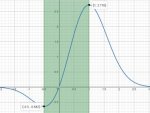Hi, I need some pointers. I need to solve Df(x)≥0 for the following function.
f(x)=xe{-x^2}+x+1
I have read up on solving derivatives, but still don't understand how to handle the case above.
as I suspect formatting problems with the function, here is the latex version:
f(x)=xe^{-x^2+x+1}
f(x)=xe{-x^2}+x+1
I have read up on solving derivatives, but still don't understand how to handle the case above.
as I suspect formatting problems with the function, here is the latex version:
f(x)=xe^{-x^2+x+1}

